By Steve Benner for CoinWeek …..
Part 1 | Part 2 | Part 3 | Part 4
* * *
Troas, unlike the subject of my previous article, was not a country unto itself.
It was only the name of a district in northwest Asia Minor (Anatolia) adjacent to the Hellespont (Dardanelles). The area is bordered by the Aegean Sea to the west, the mountain massif that forms Mount Ida (1,774 m.) to the east, the Sea of Marmara and the Dardanelles to the north, and the Gulf of Adramyttion (Edremit) to the south.
Troas is drained by two main rivers, the Scamander (Karamenderes) and the Simois, both of which originate at Mount Ida and join near the ruins of Troy. Several other rivers also originate from Mt. Ida, including Rhesos, Heptaporos, Caresus, Rhodios, Granicus (Granikos), and Aesepus. These rivers were deified by the Greeks and are usually shown as a god reclining by a river holding a reed.
The eastern and southern regions of Troas are rugged and partly wooded, which meant that most of the cities are in the western part or on the coast (Figure 1). During the bronze age, the area got its name from the Hittite word for the region, Taruiša. Troy was probably a Hittite outpost called Wiluša that controlled the region.
This part covers the following cities in alphabetical order: Abydos, Achilleion, Antandros, Birytis, Dardanos, and Gargara.

Greek cities flourished in the district during the Archaic and Classical periods with most of them producing their own coinage. The area was part of the satrapy of Hellespontine Phrygia of the Persian Achaemenid Empire. Troas was conquered by Alexander the Great in 334 BCE (all dates are BCE unless otherwise noted) and later became part of the Seleucid Empire under the Diadochi. It was ceded to Attalid Pergamon in 188, and, upon the death of Attalus III in 133, Pergamon was bequeathed to the Roman Republic.
Abydos
Abydos was located on the Nara Burnu promontory on the Asian coast of the Hellespont opposite the city of Sestos. This is the narrowest point in the straits and was where Xerxes built his pontoon bridge to transport his army to Europe. Abydos is mentioned as an ally of Troy in the Iliad. After occupation by Thracians during the Greek Dark Ages (c. 1100 – 750 BCE), the city was established in 670 as a Greek city by Milesians. It became a center for tuna export due to the abundance of fish in the Hellespont (Mediterranean tuna migrated seasonally from the Aegean to the Black Sea).
In the 520s, it was ruled by a Persian tyrant but by 514 was part of the Persian Empire. Abydos joined the Ionian Revolt in the 490s; it lost, however, and was again part of the Empire when Xerxes passed through on his way to conquer Greece.
After the Persian Wars, the city joined the Athenian-led Delian League but revolted and join the Spartans in 411. It returned to Persian rule in 387 and remained there until the Macedonians invaded Asia Minor in 336. Alexander established a mint at Abydos to exploit its nearby gold mines.
After Alexander’s death, Abydos fell under the control of various Diadochi until becoming part of the Seleucid Empire in 281. By 200, Abydos was absorbed into the Kingdom of Pergamon. As mentioned, when King Attalus III died, Pergamon, including Abydos, became part of the Roman province of Asia.
Abydos has a history of minting coins that stretches over many centuries, and the quantity and variety were prodigious. Late in the sixth and early fifth centuries, the city minted electrum and silver coins. The coin shown in Figure 2 is one of the oldest and rarest coins minted by Abydos. It is an electrum stater of the Lydo-Milesian standard (14 g.). The obverse has an eagle looking back over its shoulder and a dolphin facing downward to the right. The eagle can be found on almost all Abydos coin issues, and the dolphin was used as a subsidiary symbol on many issues. The city also minted electrum fractions of the same type.
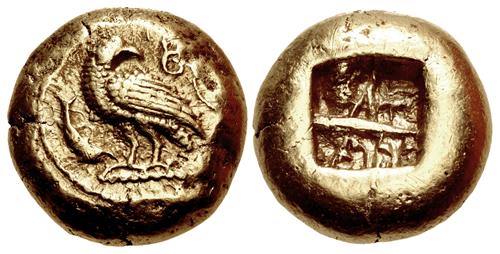
In the fifth century, the Abydos started to mint silver drachms of 5.3 grams (Persic standard) and silver fractions. These coins have an obverse of an eagle standing and a reverse of a Gorgon’s head facing forward. The Abydos ethnic on the coins is ABY. In the late fifth and fourth centuries, the city minted gold and silver coins with the eagle on the reverse. The standards used for the coin weights seem to vary a lot, and the coins are referred to as drachms, sigloi, and staters. For example, Figure 3 shows a half siglos with Apollo on the obverse and an eagle standing on the reverse.

During the fourth century, the Abydos mint became one of the most productive mints for issuing Macedonian gold staters, silver drachms, and silver tetradrachms. The main gold type has the helmeted head of Athena obverse and Nike standing left and holding a wreath reverse (Figure 4). Abydos also minted ones with the Apollo obverse and biga (two-horse chariot) reverse.

Abydos had begun minting bronze coins in the fourth century with a deity on the obverse and usually an eagle on the reverse, though sometimes it was replaced with a torch, lyre, stag, or quiver. The city continued to mint silver coins into the first century and subsequently into the Roman Republic and Empire. The mint closed down in the mid-third century CE.
This was a very brief overview of Abydos, and the city really deserves to have a full article devoted to it.
Achilleion
Achilleion’s claim to fame was it was believed to be the burial place of Achilles.
It was located on the Beşika Burnu (‘cradle promontory’) about 8 km south of Sigeion. The city was settled by Mytileneans, probably in the sixth century. Some believe that the city initially was just a fort that served as a base to attack the Athenian city of Sigeion and was under the domination of Tenedos, being only occasionally occupied. The city joined the Delian League in the 420s. It was incorporate into Lysimachus’ territory around the end of the fourth century but was uninhabited by the mid-second century.
Achilleion minted bronze coins in the latter half of the fourth century with the city ethnic of AX (ACH) on their reverse (Figure 5), sometimes within a laurel wreath. The obverse had a crested helmet with cheek protectors. This was the only coin type minted by the city.
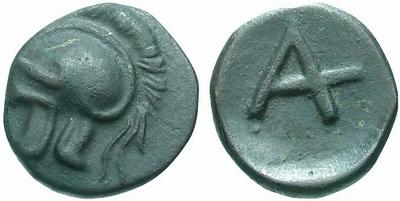
Antandros
Antandros was located on the north coast of the Gulf of Adramyttion east of Gargara and on the slope of Mt. Ida.
In the seventh century, Antandros was founded by the non-Greek people whom the Greeks believed to be aboriginal to Asia Minor. It was resettled by Aeolians in the fifth century but may have been under the influence of the city of Mytilene. By the end of the sixth century, it was part of the Persian Empire. Antandros had access to large amounts of timber and pitch, which made it ideal for the construction of large fleets and gave the city strategic importance. In the 420s, the city became part of the Delian League but returned to Persian control by 409. Xenophon’s Ten Thousand passed through the city on their way home in 399, but little is known of its history after this. This city probably became uninhabited during the Byzantine period.
By the end of the fifth century, Antandros began minting its own silver coinage of drachms (3.6 g.) and fractions (Figure 6). They had an obverse of Artemis and a reverse of a goat standing. The city ethnic used on the reverse was either ANT or ANTA. The city also minted silver fractions with a lion’s head either facing forward or to the side. These types were also used for the bronze coins minted in the fourth and third centuries.
The city stopped minting coins by the end of the third century.

Birytis
The exact location of Birytis is not known though it was probably east of Ilium. There is almost nothing known about its history. Its coins are the source of nearly all that is known about Birytis. The city may have belonged to the Delian League from 456 to 445, but this is uncertain.
Birytis minted only a silver hemiobol and several bronze coins during the latter half of the fourth and into the third century. Figure 7 shows the hemiobol with a Herakles facing obverse and Kabeiros left wearing a conical hat. Kabeiros was a pre-Greek chthonic (“in, under, or beneath the earth”) deity closely associated with that of Hephaestus and centered in the north Aegean islands of Lemnos and possibly Samothrace.

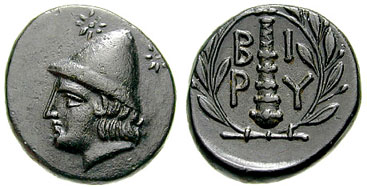
A Birytis bronze coin is shown in Figure 8. It has Kabeiros facing left and wearing a pileus on the obverse and a club in a wreath on the reverse. The city ethnic of BIPY shown around the club. The only other bronze coin type had a triskeles on the reverse.
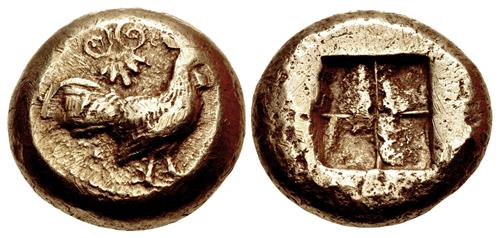
Dardanos (Dardania)
Dardanos was located south of Abydos on the Hellespont coast in the coastal plain of the Kalabakli cay. The city’s namesake, Dardanus, was the son of Zeus and the Pleiad Electra and was thought to be the ancestor of Priam of Troy and thus the Romans through Aeneas. The modern name of Dardanelles comes from the city and district. The city was an Aitolian colony and was distinct from the earlier city by that name mentioned in the Iliad.
Dardanos joined the Ionian Revolt against the Persians but was captured in 497. The city joined the Delian League and helped in the Spartan defeat at the Battle of Abydos in 411. It later came under the influence of Abydos but was freed by the Romans in 190. Sulla and Mithridates VI of Pontus met there in 85 BCE to agree on the Treaty of Dardanos.
Dardanos minted coins from the sixth through the second centuries. In the late sixth century, electrum coins attributed to Dardanos were minted to the Milesian standard. Figure 9 shows an electrum stater with a cock on the obverse and an incuse square on the reverse. The cock, either its head or standing, was used to represent the city and appears on many of these coins. An electrum issue that is older than this coin had a cross-hatch pattern on each side.

Also starting in the sixth century, Dardanos began minting silver coins, drachms (4.7g), and fractions. Figure 10 shows a horseman on the obverse and the cock on the reverse. The city ethnic is ΔAΡ and can be seen on the reverse. Almost all these coin types have a cock on the obverse or reverse with the opposite side having a variety of images including cross-hatching, incuses, bull or calf heads, and satyrs. In the mid-fourth century, Dardanos minted bronze coins that were essentially the same types as those for silver.
The city stopped minting coins sometime during the second century.
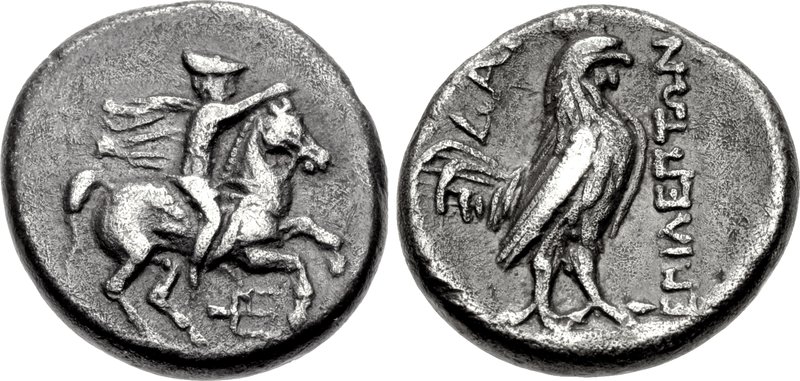
Gargara
Gargara was located on the north coast of the Gulf of Adramyttion between Assos and Antandros. Initially located near Mount Gargaron, the city was moved in the fourth century about 5.8 km to a site on the small coastal plain near the modern villages of Arıklı and Nusratlı. The previous site came to be known as Old Gargara. The area was known for its fertile land, and the name became a by-word for agricultural prosperity in Latin poetry.
The site was probably first inhabited by native Anatolians, and, in the fifth century, resettled by Aitolian Greeks. Gargara joined the Delian League and paid tribute to Athens. In the late third and early second centuries, a large influx of new settlers came to the city from Mysia, probably fleeing an invasion by Prusias II of Bithynia. There is little more information about Gargara’s history aside from occasional mentions in Greek sources.
Gargara began minting silver drachms (3.1 g.) and fractions, such as obols, tetrobols, diobols, and hemiobols, in the late fifth century. Early coins had an obverse of an Archaic female head with hair bound in sakkos and wearing a necklace and an incuse on their reverse, but early in the fourth century, the coins switch to an Apollo on the obverse and either a bull or horse on the reverse (a ram’s head on the hemiobol). The city ethnic is either ΓAΡ or ΓAΡΓ. In the sources, there seems to be some confusion as to which standard the city used for it coins. A coin of the same weight can be listed as either a tetrobol or a drachm.
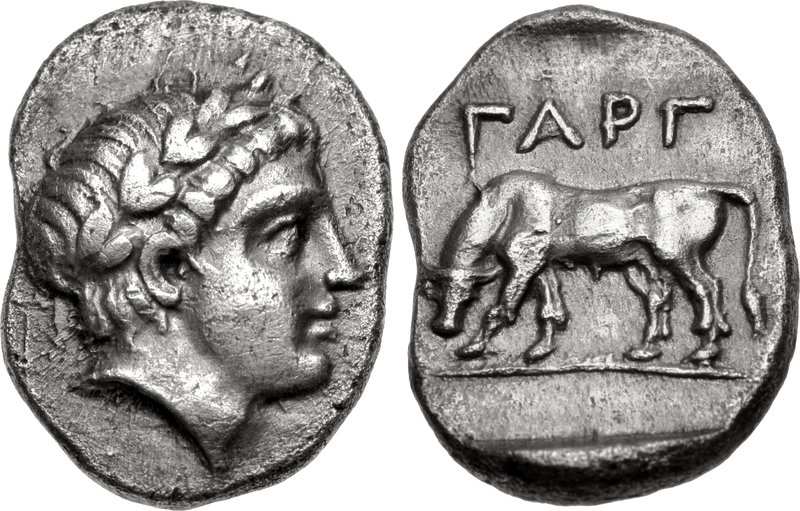
Starting in the fourth century, Gargara also minted bronze coins of various sizes that followed the same types as the silver. This changed slightly in the second century when the coins began to use Zeus as well as Apollo on the obverse. There is one small bronze that has a turreted-female head obverse and lion reverse.
The city stopped minting silver coins by end of the fourth century and bronze by the end of the second century.
Conclusion
The Troas district of Asia Minor had many cities with rich numismatic histories. The major source of knowledge of some of its cities (Birytis and Achilleion) is their coins, showing once again how important coinage can be to history. A few cities, like Abydos, were influential power brokers, harboring major mints. The lesser cities may have only produced a few types of silver and/or bronze coins, but most display the high-quality workmanship expected from Greek die-cutters. Early electrum coins tend to be very expensive (see Figures 2 and 9), and even the silver coins can be relatively pricey – especially if there are only a few examples extant. The smaller sliver fractions and bronzes can be inexpensive (see Figures 3 and 5).
* * *
References
Classical Numismatic Group (CNG)
Grant, Michael. A Guide to the Ancient World: A Dictionary of Classical Place Names. Barnes and Noble. (1986)
Head, Barclay V. Historia Numorum: A Manual of Greek Numismatics. Oxford. (1887)
Sear, David. Greek Coins and Their Values, Vol 2: Asia. B.A. Seaby Ltd. (1979)
* * *




